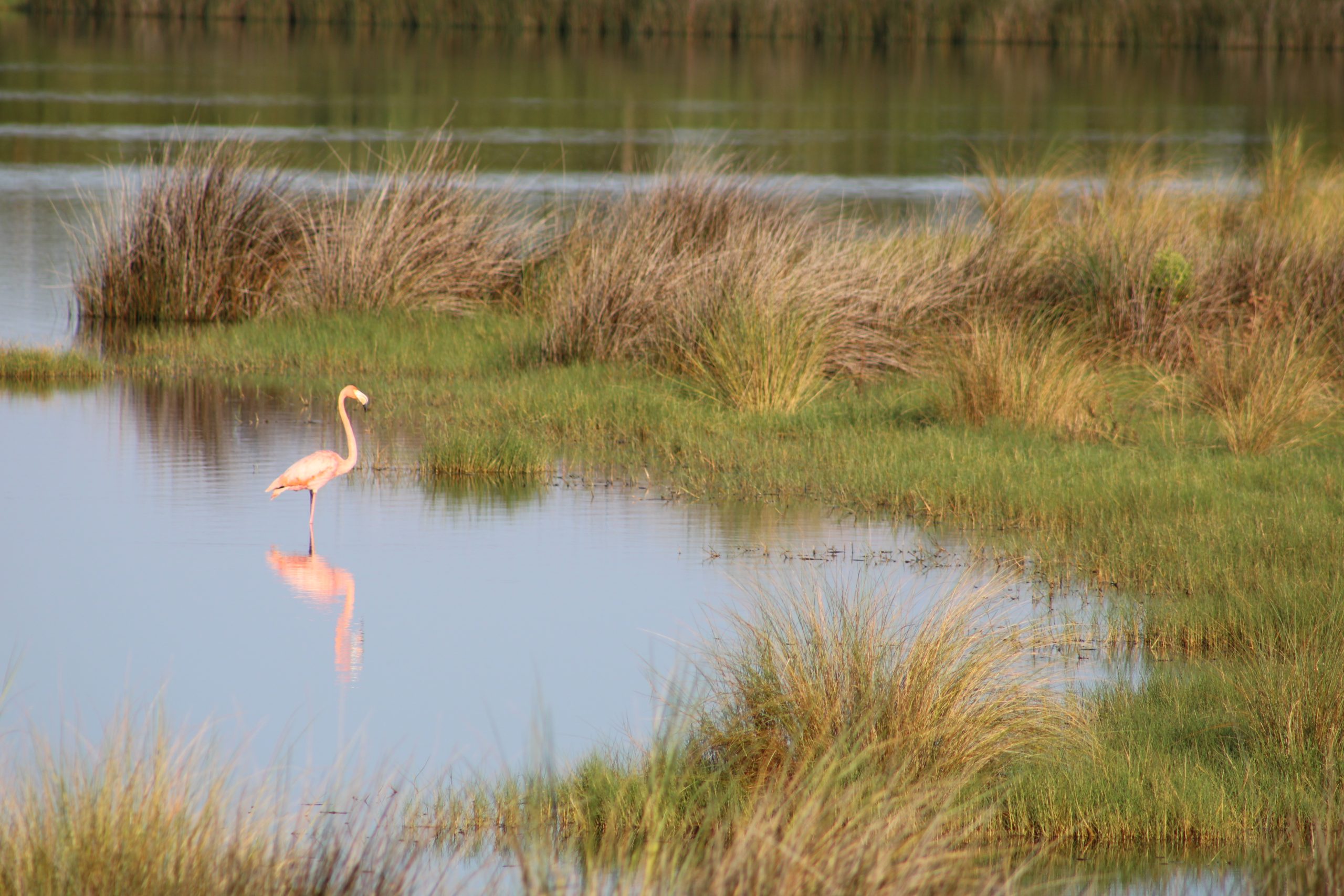If you ask me, pink animals are some of the most beautiful in the entire world. When you spot a pink creature, its bright color often sets it apart from the crowd.
If you are looking for a lengthy list of pink animals, you are in the right place. I’ll share a summary list and then take a closer look at these red beauties below.
Key Facts:
- Many pink animals get their beautiful colors from the food they eat.
- Flamingos and Roseate Spoonbills are two of my favorite pink animals!
30 Pink Animals: A Summary List
- Roseate Spoonbill
- American Flamingo
- Amazon River Dolphin
- Pink Fairy Armadillo
- Pink Katydid
- Pink Orchid Mantis
- Web-footed gecko
- Earthworm
- Domesticated pigs
- Elephant Hawkmoth
- Axolotl
- Sea Anemone
- Pink Hairy Squat Lobster
- Nudibranch
- Pink Robin
- Pink Dragon Millipede
- Naked Mole Rats
- Roseate Skimmer
- Major Mitchell’s Cockatoo
- Galah
- Primrose Moth
- Bargibant’s Seahorse
- Pink Sea Star
- Sonoran Coachwhip
- Pine Grosbeak
- Himalayan White-Browed Rosefinch
- Galapagos Pink Land Iguana
- Northern Carmine Bee-Eater
- Bourke’s Parakeet
- Giant Frogfish
30 Pink Animals: A Closer Look
Ready to learn more about the pink animals included on our list? Dive into the details below.
Roseate Spoonbill
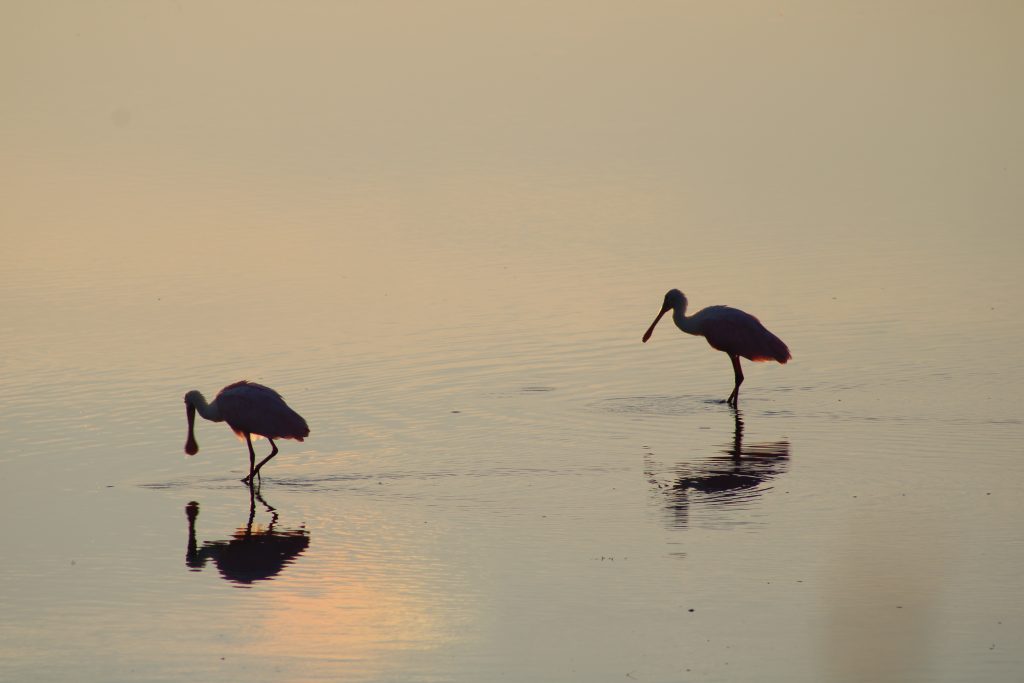
The Roseate Spoonbill (Platalea ajaja) is a stunning wading bird distinguished by its vibrant pink plumage and unique spoon-shaped bill. The striking pink coloration results from the pigments in the crustaceans and other aquatic invertebrates that constitute a significant part of their diet.
These large waders, with a wingspan reaching up to 50 inches, inhabit wetlands and coastal areas of the Americas, showcasing their majestic pink hues against the backdrop of marshes and shallow waters.
American Flamingo
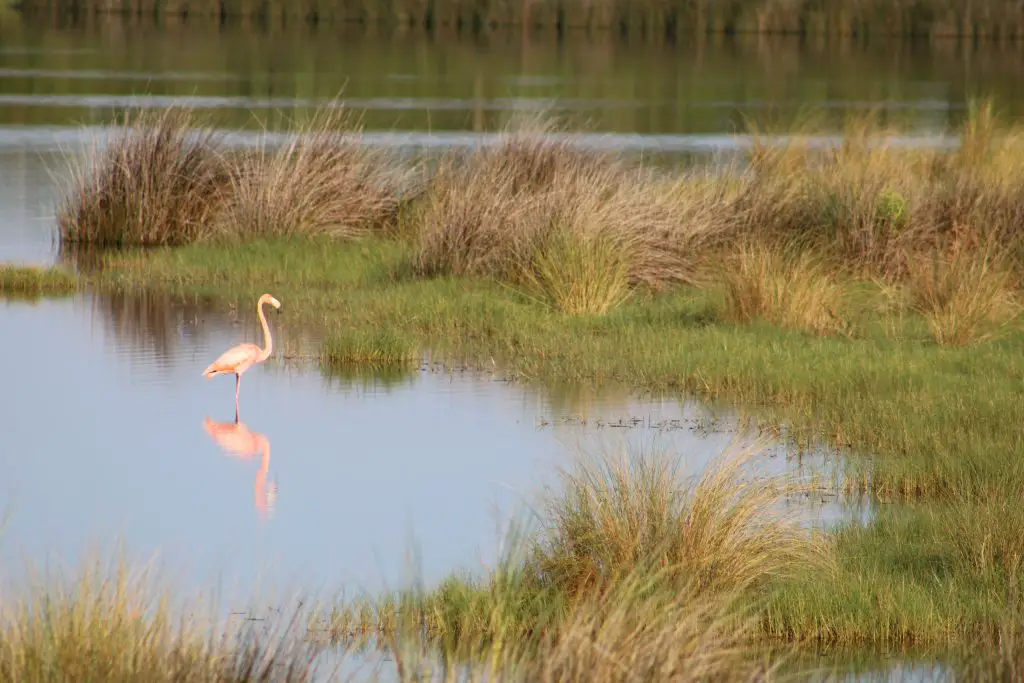
The American Flamingo (Phoenicopterus ruber) has iconic pink plumage, a result of the pigments in the crustaceans and algae in their diet. The large wading birds have long necks and legs and inhabit the shallow waters of coastal areas, lagoons, and salt flats, showcasing their stunning pink hues against various aquatic backdrops.
Amazon River Dolphin
The Amazon River Dolphin (Inia geoffrensis) is recognized for its distinctive pink coloration. The pink hue is attributed to the presence of blood vessels near the surface of their skin, which become more visible as the dolphins age. These elusive freshwater dolphins, also known as “boto,” inhabit the Amazon and Orinoco river systems, showcasing their enchanting pink tones amid the murky waters of the tropical rainforests.
While the conservation status of Amazon River Dolphins varies among regions, certain populations face threats from habitat degradation, pollution, and accidental entanglement in fishing gear. Conservation efforts focus on mitigating these threats, promoting sustainable fisheries practices, and preserving the diverse aquatic ecosystems where these captivating pink dolphins live.
Pink Fairy Armadillo
The Pink Fairy Armadillo (Chlamyphorus truncates) is a diminutive and elusive mammal with a pinkish hue. The pink coloration of this armadillo is attributed to the blood vessels near the surface of its shell, providing a delicate and enchanting appearance. Native to the sandy plains and grasslands of central Argentina, these small armored mammals are primarily nocturnal, burrowing beneath the ground to avoid the harsh daytime heat.
Pink Katydid
The Pink Katydid, scientifically known as Eulophophyllum kirki, is a rare insect species with distinctive pink coloration. The reason for their pink coloration is not entirely understood. But it is believed to be a result of a genetic mutation affecting the pigments in their exoskeleton. These unique katydids, found in parts of Malaysia and Thailand, stand out against the lush green foliage of their tropical habitats.
Pink Orchid Mantis
The Pink Orchid Mantis (Hymenopus coronatus) is a visually stunning insect celebrated for its exquisite pink coloration and remarkable mimicry. The vibrant pink hues of these mantises serve as a form of camouflage, helping them blend seamlessly into the tropical flowers where they dwell, particularly orchids. This camouflage not only aids in ambushing prey but also contributes to their captivating appearance.
Physically, the Pink Orchid Mantis features a slender body and long, spiky limbs, resembling the petals of an orchid flower. The camouflage helps these insects lie in wait for prey that comes within striking range.
Web-footed gecko
The Web-Footed Gecko is a reptile living in the arid regions of Namibia, Angola, and South Africa. While not entirely pink, these geckos have a pinkish coloration, providing effective camouflage in the sandy desert environments they inhabit. The pinkish hues result from pigments in their skin that help them blend seamlessly into the reddish-brown sand dunes.
These geckos are nocturnal and rely on their keen sense of hearing and specialized toes to navigate the desert landscape and locate prey.
Earthworm
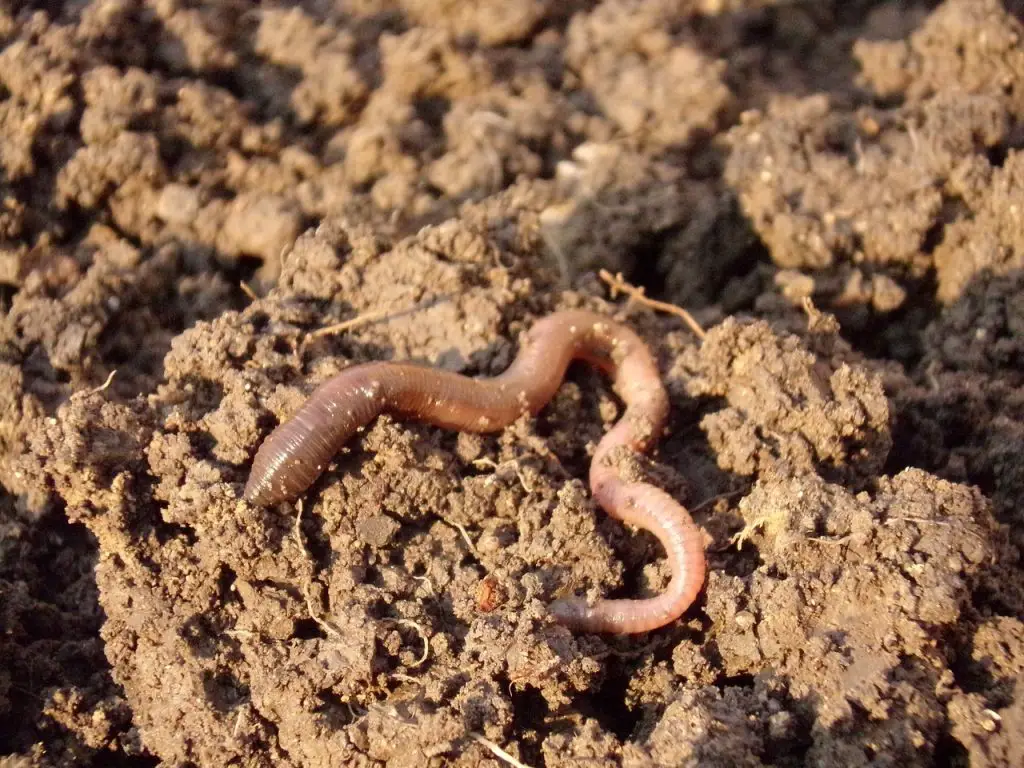
The earthworm is an often overlooked creature in the ecosystem. It plays a crucial role in soil health and fertility. While not naturally pink, certain species of earthworms may exhibit a reddish hue due to the presence of hemoglobin in their blood, which helps transport oxygen. This coloration is more visible in earthworms that live close to the soil surface, where oxygen levels are higher.
Earthworms are essential for maintaining soil structure and fertility, making them valuable allies for agriculture and plant growth.
Domesticated pigs
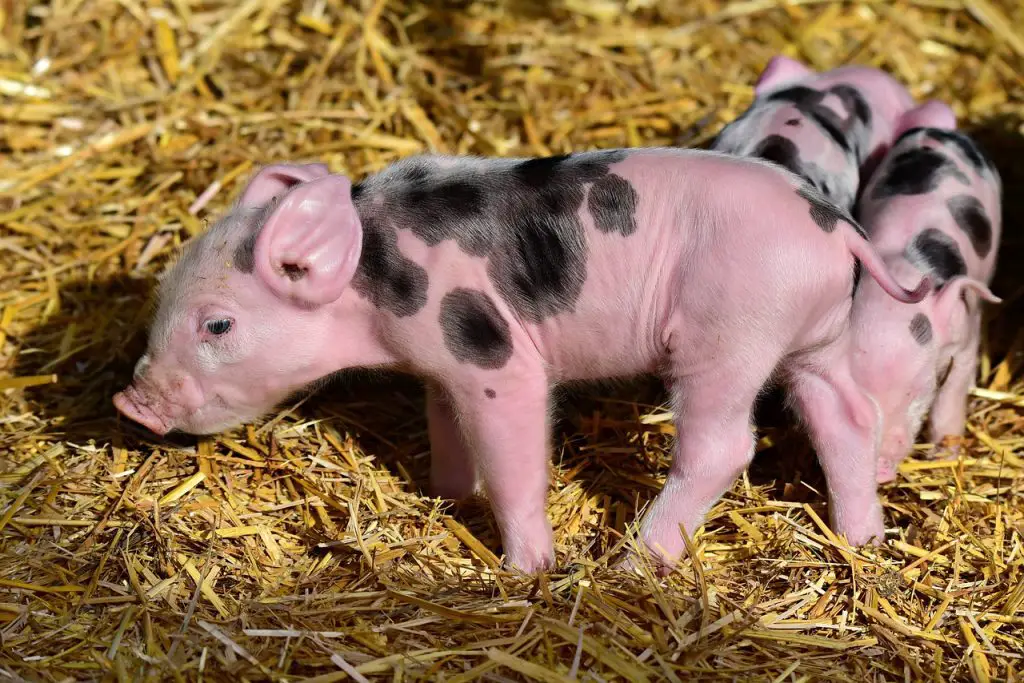
While domesticated pigs can exhibit various coat colors, including pink, their reddish-pink skin is often more visible in breeds with lighter coats. This coloration results from the presence of blood vessels near the surface of the skin and contributes to their distinctive appearance.
Domesticated pigs are also known for their strong sense of smell, which they use for foraging and rooting in search of food.
Elephant Hawkmoth
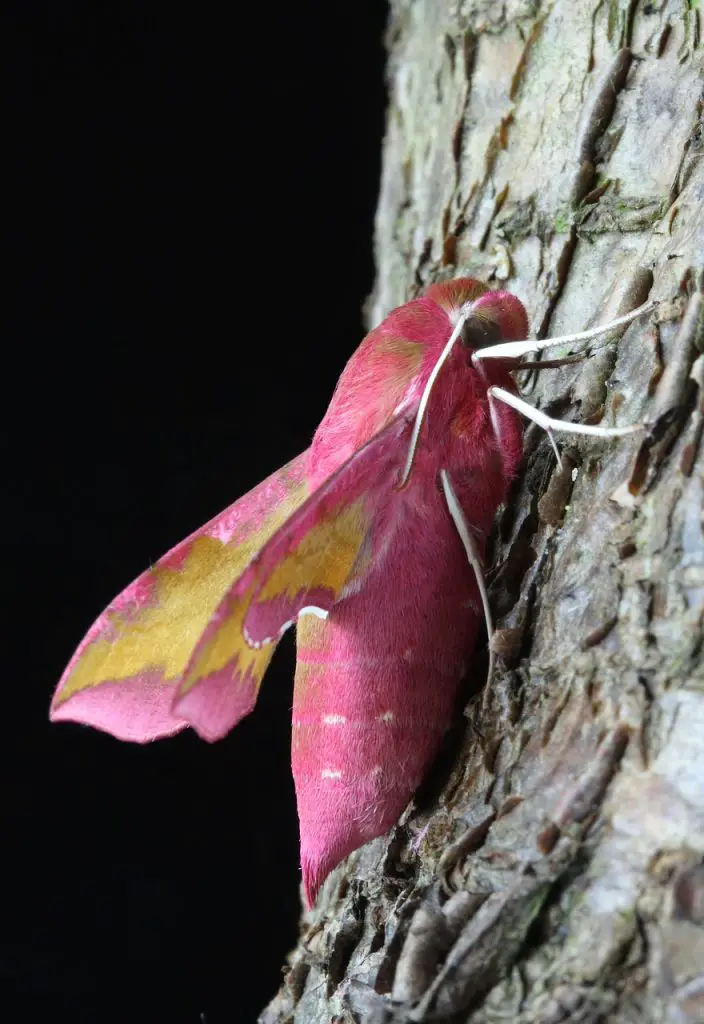
The Elephant Hawkmoth (Deilephila elpenor) has a striking pink and olive-green coloration. The reddish-pink hues of this moth serve as a form of camouflage, allowing it to blend seamlessly with the flowers it frequents. This adaptability makes the Elephant Hawkmoth a master of disguise in various floral environments, from gardens to meadows.
Axolotl
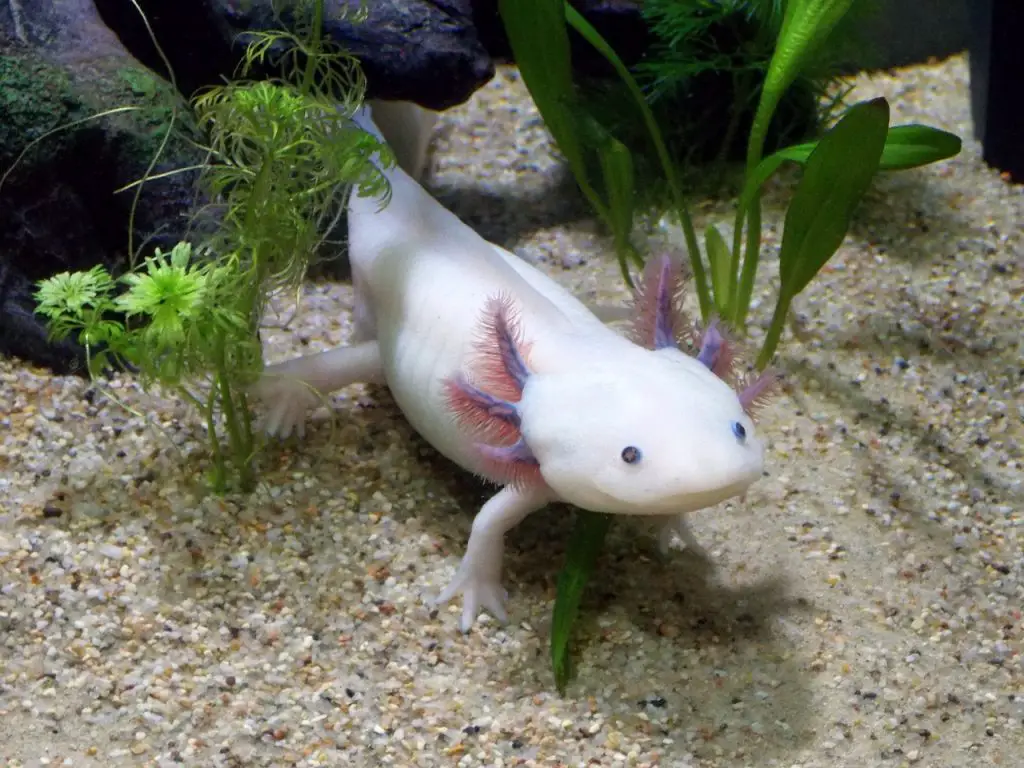
The Axolotl, scientifically known as Ambystoma mexicanum, is a unique aquatic salamander with a charming appearance and remarkable regenerative abilities.
While axolotls can display various colors, including pinkish hues, the red coloration is often attributed to their genetics and can intensify under certain conditions. These neotenic creatures retain their aquatic larval features throughout their entire life, showcasing external gills, feathery external projections, and a friendly facial expression.
Sea Anemone
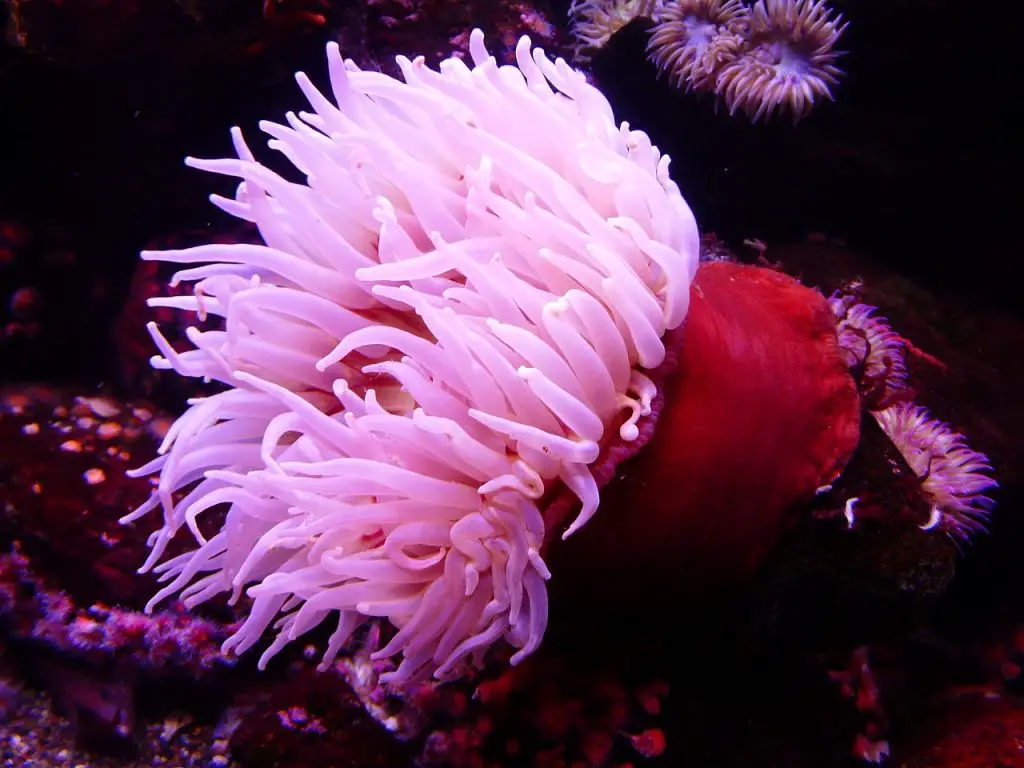
The Sea Anemone exhibits a diverse array of colors, including shades of pink, which are often attributed to the presence of pigments like chlorophyll and carotenoids within their cells.
Pink Hairy Squat Lobster
The Pink Hairy Squat Lobster, scientifically known as Lauriea siagiani, is a crustacean with pink coloration. Found in deep-sea environments, this squat lobster’s pink hues are believed to be a result of its diet. This pink color helps it blend seamlessly into the vibrant hues of the deep-sea corals and sponges that it inhabits.
Nudibranch
The Nudibranch belongs to the class Gastropoda and is known for its captivating and diverse colors. Some of these marine gastropods are renowned for their striking pink coloration, which serves various purposes, including warning potential predators of their toxicity. The red hues are often derived from the nudibranch’s diet, incorporating pigments from the sponges they consume.
Pink Robin
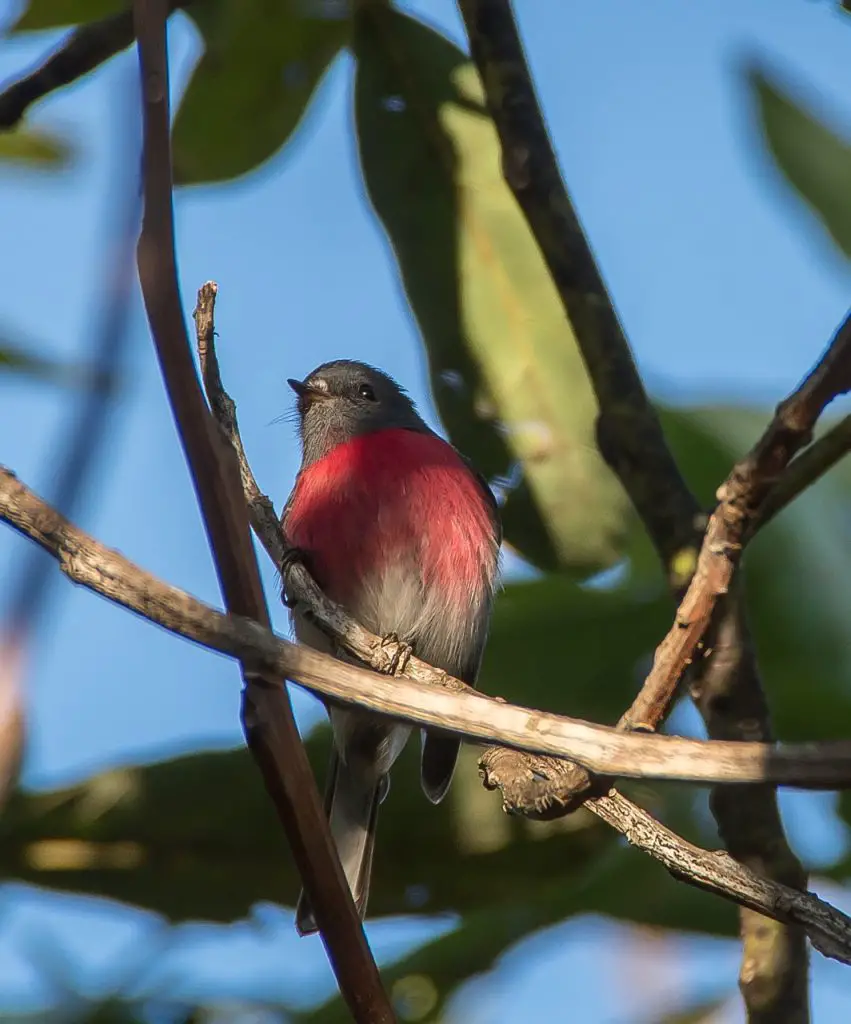
The Pink Robin (Petroica rodinogaster) is native to southeastern Australia. While the male Pink Robin dons a striking pinkish-red plumage on its breast and belly, with females exhibiting a more subdued grayish-brown hue for enhanced camouflage during nesting.
Pink Dragon Millipede
The Pink Dragon Millipede, scientifically known as Desmoxytes purpurosea, is a fascinating arthropod found in the forests of Thailand. This millipede’s striking hues are attributed to the presence of cyanide compounds in its exoskeleton, serving as a potent deterrent against predators. The vivid pink coloration acts as a warning signal, indicating the potential toxicity of this intriguing millipede.
Naked Mole Rats
The Naked Mole Rat, scientifically known as Heterocephalus glaber, is a remarkable subterranean mammal native to East Africa, particularly found in Ethiopia, Kenya, and Somalia.
Despite their name, naked mole rats are not truly hairless; instead, they have fine, nearly invisible hairs. One distinctive feature of these social rodents is their pinkish or reddish-brown skin, which results from the absence of a fur coat and the visibility of blood vessels. This adaptation helps them efficiently navigate through their dark underground tunnels without the hindrance of fur.
Roseate Skimmer
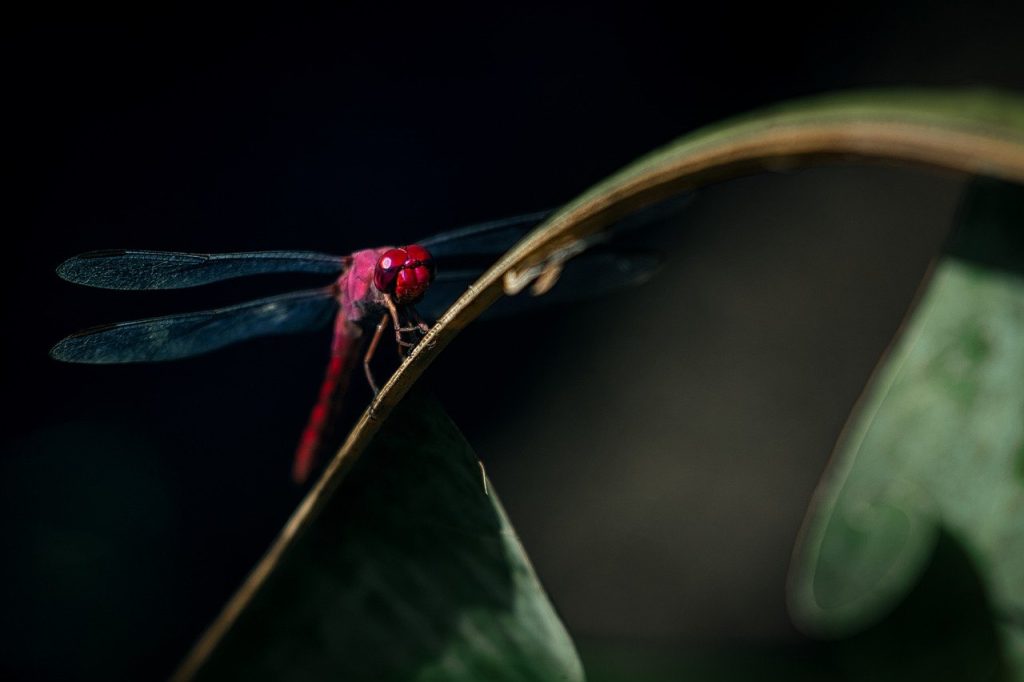
The Roseate Skimmer (Orthemis ferruginea) is a dazzling dragonfly species found across North America, from the United States to Mexico. Renowned for its vibrant pink coloration, this dragonfly’s striking hues are primarily due to pigments in its exoskeleton, which reflect and refract light to create a radiant appearance.
The Roseate Skimmer lives near still or slow-moving waters, such as ponds, lakes, and marshes, where it showcases its vibrant colors against the backdrop of aquatic vegetation.
Major Mitchell’s Cockatoo
The Major Mitchell’s Cockatoo is a parrot species native to Australia. The medium-sized parrot has stunning pink and peach-colored plumage.
These cockatoos live in arid and semi-arid regions, showcasing their vibrant colors against the backdrop of the Australian landscape.
Galah
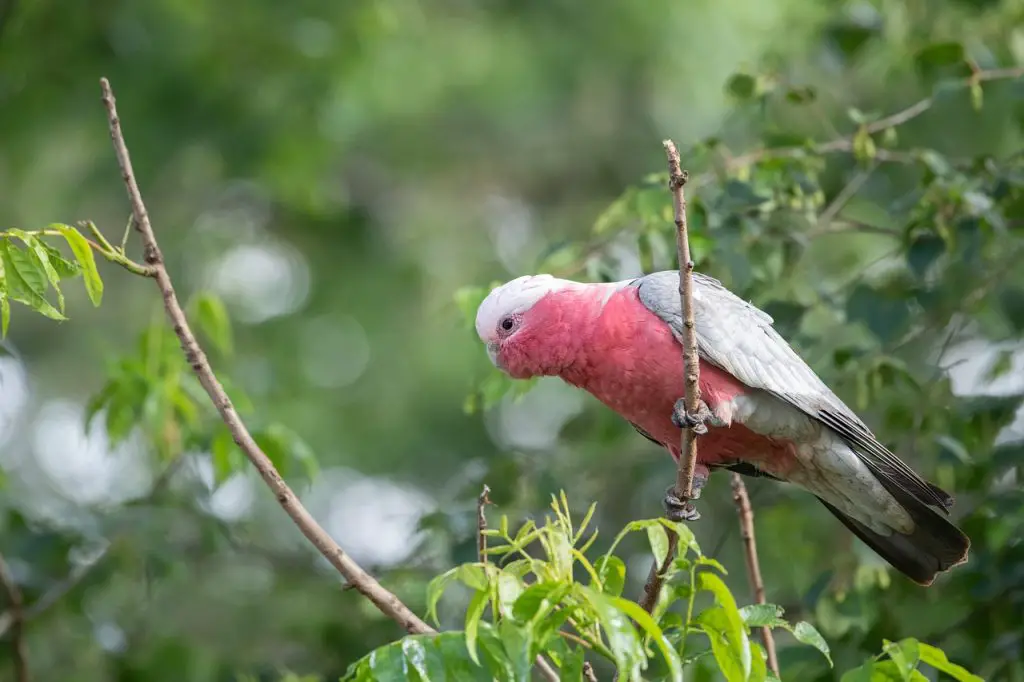
The Galah (Eolophus roseicapilla) is another parrot species native to Australia. They have distinctive pink and grey plumage. These social birds live in large flocks across various Australian habitats, from open woodlands to urban areas, showcasing their vibrant hues against the landscape.
Primrose Moth
The Primrose Moth (Schinia Florida) is an insect with a delicate pink coloration. The vibrant pink hues of this moth are a result of pigments in its wings, providing effective camouflage among the blossoms of its preferred host plant, the evening primrose. This color adaptation allows the Primrose Moth to blend seamlessly into its floral surroundings, aiding in both protection and effective pollination.
The Primrose Moth is a small, nocturnal moth with a wingspan of about 1 to 1.5 inches. Its delicate pink wings are adorned with intricate markings, creating a visually stunning display.
Bargibant’s Seahorse
Bargibant’s Seahorse, Hippocampus bargibanti, is a mesmerizing marine creature with vibrant pink and red hues. The striking coloration of these seahorses is primarily a result of their ability to mimic the colors of their preferred habitats, which include gorgonian sea fans. This color adaptation allows Bargibant’s Seahorse to blend seamlessly into the intricate branches of these coral species, providing effective camouflage against potential predators.
Physically, Bargibant’s Seahorse is a tiny species, with males reaching lengths of about 1.5 to 2.5 centimeters.
Pink Sea Star
The Pink Sea Star (Pisaster brevispinus) is a marine invertebrate with vibrant pink and red coloration. This sea star’s striking hues are attributed to pigments within its skin, creating an eye-catching display against the backdrop of coastal habitats. Found along the Pacific coast of North America, from Alaska to Baja California, the Pink Sea Star plays a vital role in maintaining the health and balance of intertidal ecosystems.
Sonoran Coachwhip
Renowned for its vibrant red and pink hues, the Sonoran Coachwhip’s coloration is linked to its specific habitat and environment, providing effective camouflage in arid landscapes. This adaptation aids the snake in both hunting for prey and evading potential predators.
Pine Grosbeak

The Pine Grosbeak, scientifically known as Pinicola enucleator, is a striking bird species known for its vibrant pink plumage. The pink coloration in males is attributed to carotenoid pigments obtained from their diet, particularly the consumption of berries and fruits. This adaptation not only contributes to their aesthetic appeal but also serves as a visual indicator of health and vitality during courtship displays.
Himalayan White-Browed Rosefinch
The Himalayan White-browed Rosefinch is a medium-sized bird with a distinctive white stripe above its eyes, complementing its overall pink and red plumage. They prefer to live in alpine meadows and high-altitude habitats, showcasing their resilience in challenging environments.
Galapagos Pink Land Iguana
The Galapagos Pink Land Iguana has a robust body and spiky dorsal scales. And, of course, a distinctive pinkish hue, especially evident on their skin and scales. It lives on Isabela Island in the Galapagos Archipelago.
Northern Carmine Bee-Eater

The Northern Carmine Bee-eater, scientifically known as Merops nubicus, is a bird species native to sub-Saharan Africa.
Bourke’s Parakeet

Bourke’s parakeet is a small parakeet native to Australia. While these birds come in many different colors, some have beautiful pink feathers.
Giant Frogfish
The Giant Frogfish, scientifically known as Antennarius commerson, is a fascinating marine species belonging to the family Antennariidae. The pink pigments in the skin of the Giant Frogfish serve as both a form of camouflage and a means of attracting prey.
Why are some animals pink?
Animals can appear pink due to various factors, and the specific reasons may vary across species. Here are some common reasons why certain animals display pink coloration:
- Dietary Pigments. The consumption of pigments in certain foods, such as red and pink algae, crustaceans, or fruits, can influence the coloration of an animal’s skin, feathers, or scales. Flamingos, for example, get their pink color from the pigments in the carotenoid-rich algae and crustaceans they consume.
- Genetic Factors. Genetic variations can play a role in determining the coloration of an animal. Certain species may have inherited genetic traits that result in pink hues, either naturally or through selective breeding in captivity.
- Camouflage. In some cases, animals may exhibit pink coloration as a form of camouflage. This is particularly true for species living in environments with pinkish hues, such as coral reefs. Pink coloration helps them blend into their surroundings, making it easier to hunt or avoid predators.
- Mating Displays: Pink coloration can serve as a visual signal during courtship rituals. Bright and vibrant colors, including pink, can attract potential mates and play a role in reproductive success.
- Thermoregulation. In certain animals, especially birds, pink coloration might be related to thermoregulation. Blood vessels close to the skin’s surface can contribute to the pink color, helping to regulate body temperature by dissipating heat more efficiently.
Animals That Are Pink: Frequently Asked Questions
You have questions about pink animals. We have answers.
What animal has a pink color?
Some animals with a pink color include American Flamingos, Roseate Spoonbills, and Bourke’s parakeet.

